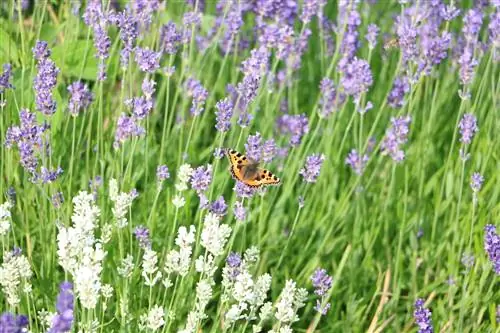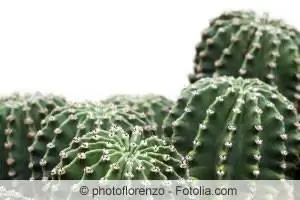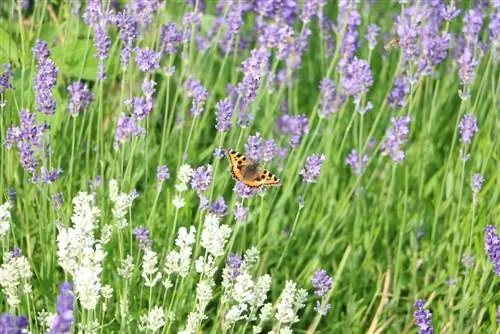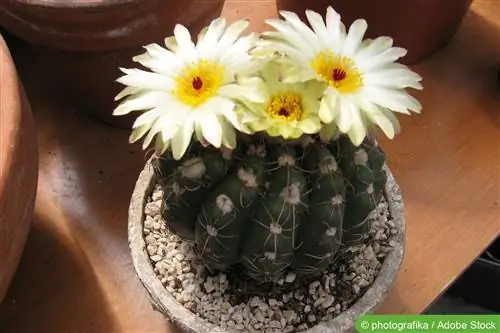- Author admin [email protected].
- Public 2023-12-17 03:39.
- Last modified 2025-06-01 06:48.
Lavender is one of the most popular plants for the garden and balcony, is easy to care for and enchants with its scent, flowers or both at the same time. While one persists, the other begins to fade away in early autumn. Choosing annual or perennial lavender varieties is crucial.
The choice of an annual or perennial type of lavender not only determines the lifespan of the plant, but also the effort required. Some are quite frugal and can almost be left to their own devices, while others have to take some measures in order to thrive in the long term.
From selection to winter storage - the right approach is important for success, not just for beginners in garden care.
Annual or perennial?
Although the names for lavender are persistent, there are actually only perennial varieties. The reason for the short lifespan of some species is simply their lack of frost hardiness. So they haven't reached the end of their lives, but are freezing to death. Of course, this can be counteracted by bringing the plants indoors in time for overwintering. If you don't want to go to this expense, you can replace the lavender in spring or choose a hardy variety straight away. However, the individual lavender varieties differ not only in their cold tolerance.
Annual varieties
Lavender species that are not hardy include:
- Flower Lavender
- Oregano-Lavender
- Lavandula Intermedia
- Speik Lavender
- Wool Lavender
However, there are exceptions here. Some newer cultivars can withstand frost - so they can also be protected over the winter outdoors.
Flower Lavender
The crested lavender has somewhat peculiar flowers. The feathery trimmings of the flower spikes, which sit high above the plant, make it look as if tiny butterflies are sitting on them at all times. The scent they give off is fresh, spicy and can be reminiscent of camphor.
The crested lavender can be grown as a shrub or standard tree.
Oregano-Lavender
The oregano lavender is also somewhat unusual. Its leaves are branched and wide, which sets it in stark contrast to other lavender varieties. The scent also differs and is close to that of - the namesake - oregano.
Lavandula Intermedia
Lavandula Intermedia is a mixture of spike lavender and real lavender. The overall appearance is straight and delicate. The flowers can be white, pink or purple in color. Some varieties are hardy and wintergreen.
Speik Lavender
Speik lavender can grow to very large sizes and exudes an intense, sometimes pungent scent. This not only brings freshness to the garden, it also keeps pests away from the Speik lavender and surrounding plants.
Wool Lavender
The wool lavender grows more wide than tall, but can reach heights of 75 cm. While the silvery herb is bushy and dense in appearance, the delicate flowers are scattered above the greenery. They and the leaves emit a sweet, aromatic scent.
Winter-hardy varieties
Lavender varieties that are at least winter-proof - meaning they can overwinter outdoors with protection - are:
- Shrub Lavender
- Garden Lavender
- Provence lavender
- True Lavender or Lavandula Angustifolia
Real lavender can usually even survive without protection, so it is hardy.
Shrub Lavender
The shrub lavender survives the winter well outdoors with appropriate protection - and that's a good thing. Because with a height of up to 1.80 meters, it requires plenty of space.
Garden Lavender
The garden lavender is a pasture for bees that also pleases human noses with its intense scent. It can reach a height of around 40 cm, and the flowers even grow up to 60 cm high. The contrast between dark sepals and delicately colored flowers is particularly beautiful to look at.
Provence lavender
The Provence lavender is also an intermedia species and is therefore only winter-proof with sufficient protection. There are also different flower colors. The growth is slim and delicate.
Real Lavender
As the only type of lavender, real lavender can now also be found growing wild in home gardens. It partially self-sows, survives winters outdoors without protection and has a more bitter than sweet scent. It is also particularly easy to care for.
Location
Lavender generally needs a sunny location where it is as warm as possible at all times. A spot in front of the south wall of the house or a balcony where the heat accumulates is well tolerated. Protection from wind and unbridled weather ensures prosperity.
Substrate & Pouring
When it comes to the substrate for lavender, you should choose a nutrient-poor variant. Herbal soil that is loosened with sand or gravel and garden lime is well suited.
While lavender can withstand even blazing sun on hot days, it is extremely sensitive to waterlogging and excessive humidity. So be careful when watering. Fresh tap water can be used for this, the lime content doesn't bother the lavender.
Fertilize
The different types of lavender differ when it comes to fertilization. If you grow the plants as annuals anyway, you don't need to fertilize them at all. However, if they overwinter or are hardy, additional nutrients should be given in spring.
Compost and potash fertilizer are ideal.
Blend
The offcuts are different again. Lavender varieties that have been cultivated for several years should be cut annually in spring. This measure ensures compact growth. Only about a third of the length should be shortened so as not to put unnecessary strain on the plant. Older lavender can be cut by up to two thirds. Dried, wilted or damaged shoots must be removed at any time.
Wintering
Lavender varieties grown as annuals require winter quarters if they are to continue to impress with their scent in the coming year. A bright, cool room with at least 5 °C is suitable. The exact temperature depends on the requirements of the respective variety. To do this, the plants should be watered sparingly every now and then to prevent them from drying out completely. Species that are outside should be protected with garden fleece and bamboo mats. However, a completely light-tight cover is not recommended as the lavender suffers from the lack of light.
Pests and diseases
Due to its high content of essential oils, there is no need to worry about pests on lavender. On the disease side, the only things to be found are rot and fungal infections. However, these only occur if the lavender is too moist. A suitable location and adapted watering behavior are therefore the best prevention.
Frequently asked questions
Is lavender suitable for consumption?
Whether lavender is suitable for cooking and baking depends on the variety. The flowers of real lavender and wool lavender are harmless and an unusual ingredient at the same time.
Is lavender poisonous to animals?
Parts of lavender and its oil can be poisonous depending on the variety. Pets and children should therefore not be allowed to consume it.
How old can lavender live?
With good care and suitable overwintering, lavender can live to be ten years old.
What you should know about lavender types in brief
Annual types of lavender
- All lavender varieties are perennial plants that can grow for several years in good conditions.
- However, there are species that do not survive the Central European winter outdoors, so they can be described as annuals.
- In a frost-free place in winter, they will last longer than a year.
- However, they die outdoors, so they have to be sown again next year or replaced with new plants from garden shops.
- These include: Oregano Lavender, Schopflavender, Lavandula Intermedia, Speik Lavender and Wool Lavender.
Perennial Lavender Varieties
- The perennial lavender plants are mostly subshrubs that become woody from below over time.
- With 1-2 strong cuts per year you can prevent the perennial wood from becoming too bald.
- The best-known lavender varieties include: garden lavender, Provence lavender, shrub lavender and real lavender.






